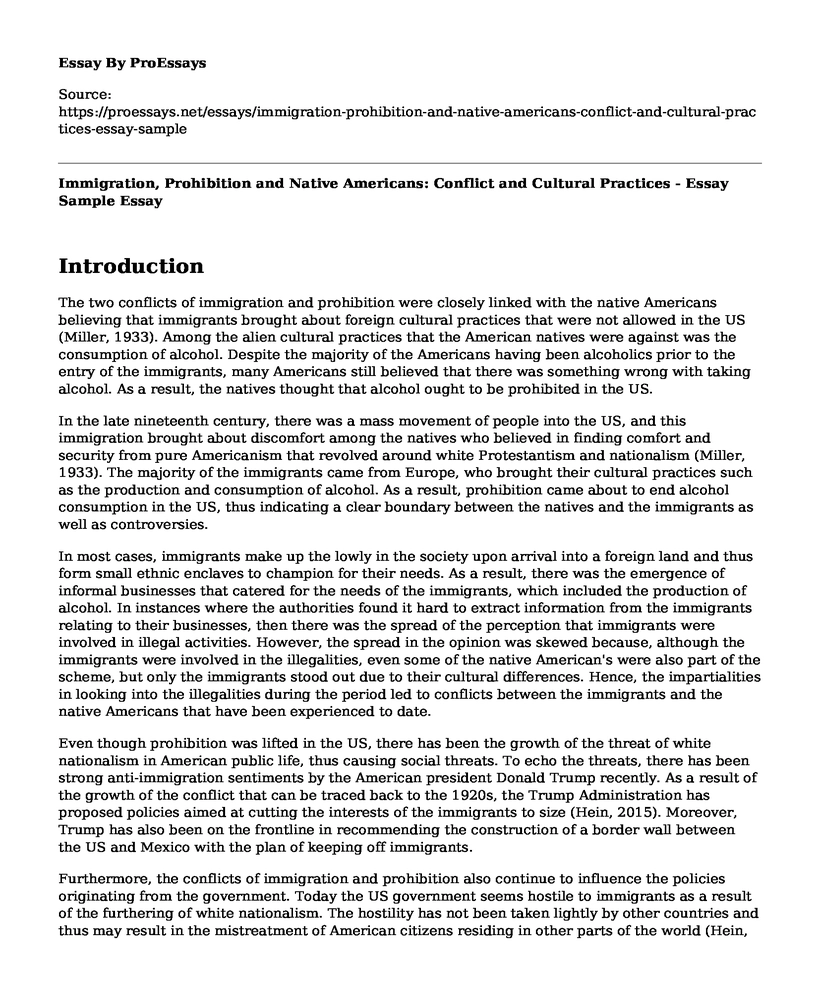Introduction
The two conflicts of immigration and prohibition were closely linked with the native Americans believing that immigrants brought about foreign cultural practices that were not allowed in the US (Miller, 1933). Among the alien cultural practices that the American natives were against was the consumption of alcohol. Despite the majority of the Americans having been alcoholics prior to the entry of the immigrants, many Americans still believed that there was something wrong with taking alcohol. As a result, the natives thought that alcohol ought to be prohibited in the US.
In the late nineteenth century, there was a mass movement of people into the US, and this immigration brought about discomfort among the natives who believed in finding comfort and security from pure Americanism that revolved around white Protestantism and nationalism (Miller, 1933). The majority of the immigrants came from Europe, who brought their cultural practices such as the production and consumption of alcohol. As a result, prohibition came about to end alcohol consumption in the US, thus indicating a clear boundary between the natives and the immigrants as well as controversies.
In most cases, immigrants make up the lowly in the society upon arrival into a foreign land and thus form small ethnic enclaves to champion for their needs. As a result, there was the emergence of informal businesses that catered for the needs of the immigrants, which included the production of alcohol. In instances where the authorities found it hard to extract information from the immigrants relating to their businesses, then there was the spread of the perception that immigrants were involved in illegal activities. However, the spread in the opinion was skewed because, although the immigrants were involved in the illegalities, even some of the native American's were also part of the scheme, but only the immigrants stood out due to their cultural differences. Hence, the impartialities in looking into the illegalities during the period led to conflicts between the immigrants and the native Americans that have been experienced to date.
Even though prohibition was lifted in the US, there has been the growth of the threat of white nationalism in American public life, thus causing social threats. To echo the threats, there has been strong anti-immigration sentiments by the American president Donald Trump recently. As a result of the growth of the conflict that can be traced back to the 1920s, the Trump Administration has proposed policies aimed at cutting the interests of the immigrants to size (Hein, 2015). Moreover, Trump has also been on the frontline in recommending the construction of a border wall between the US and Mexico with the plan of keeping off immigrants.
Furthermore, the conflicts of immigration and prohibition also continue to influence the policies originating from the government. Today the US government seems hostile to immigrants as a result of the furthering of white nationalism. The hostility has not been taken lightly by other countries and thus may result in the mistreatment of American citizens residing in other parts of the world (Hein, 2015). Additionally, other cultural challenges that exist in the US include the perception by the white nationalists that immigrants from the middle east pose a terror threat to the US, ignoring the fact that not all immigrants are terrorist sympathizers. Also, the mistrust that exists between the immigrants and the police is a result of the stereotypes that developed back in the 1920s during the immigration and prohibition conflicts.
Conclusion
In conclusion, the entry of immigrants into the US back in the 1920s brought about conflicts with the natives due to issues such as the need to further white nationalism and the different cultural practices. As a result of the disputes, American society continues to suffer the impacts of the conflicts in its governance as well as how they relate with other nations hence making the current cultural challenges in the US identical to the nativist worldview that dominated the US in the 1920s.
References
Hein, L. E. (2015). Living with the bomb: American and Japanese cultural conflicts in the nuclear age. https://doi.org/10.4324/9781315702803
Miller, H. A. (1933). Immigration: Cultural conflicts and social Adjustments. Lawrence guy Brown. American Journal of Sociology, 39(3), 405-406. https://doi.org/10.1086/216444
Cite this page
Immigration, Prohibition and Native Americans: Conflict and Cultural Practices - Essay Sample. (2023, May 04). Retrieved from https://proessays.net/essays/immigration-prohibition-and-native-americans-conflict-and-cultural-practices-essay-sample
If you are the original author of this essay and no longer wish to have it published on the ProEssays website, please click below to request its removal:
- Case Studies on Drug Abuse
- An Addiction or Disease Gaming: Harmful Video Games - Essay Sample
- The Evolution of Zoos - Essay Sample
- Global Nutritional Issues Paper Example
- Essay Sample on Generic Drug Pricing
- Essay Example on Invisible Privileges: Unseen Power in Society
- Essay Sample on Woman's Trauma: Husband's Abuse Evident in Police Call







